Last Updated on March 19, 2025
Invasive garlic mustard plant turns out to be a delicious addition to the forager’s table. Help fight the invader by cooking up loads of this pernicious weed in tasty garlic mustard recipes!
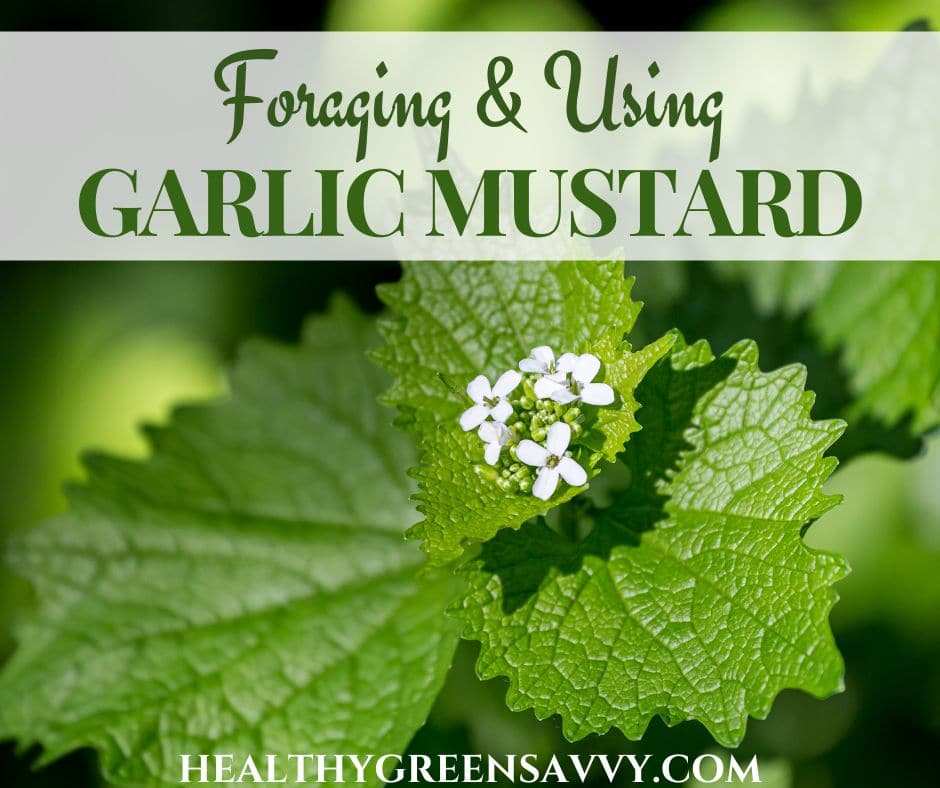
Ever tried garlic mustard? This common invasive weed is surprisingly tasty in numerous garlic mustard recipes to enjoy in springtime.
Unlike so many foraged foods, where you need to harvest sparingly, with garlic mustard plants you can pick as much as you can carry. Garlic mustard plant is so invasive, you’re doing the world a favor by picking far more than you will be able to use. And it’s so tasty — especially picked early in the season, you will happily use a lot of it.
WHAT IS GARLIC MUSTARD?
Garlic mustard (Alliaria petiolata) is a plant in the brassica family brought to North America by European settlers for food and medicine. Also known as hedge garlic or sauce alone, it’s long been used by springtime foragers looking for tasty wild plants to add flavor to their tables.
Like many other non-native species, garlic mustard plants threaten local ecosystems by outcompeting native plants that pollinators rely on for food.
Garlic mustard plants emerge earlier in the spring than native plants and crowd them out, upsetting the delicate ecological balance of flora and the fauna that depend on the native plant species they evolved with. A compound exuded from the roots inhibits mycorrhizae and germination of other plants’ seeds, making it still more difficult for natives to compete.
A biennial plant, garlic mustard is small in its first year but sends up a flower stalk reaching up to three feet in its second. If left undisturbed, those flowers will set hundreds of seeds. They can remain viable as long as twelve years, so garlic mustard is all too good at propagating itself.
IS GARLIC MUSTARD EDIBLE?
Oh, my yes, garlic mustard is not only edible, it can be very tasty!
As a longtime forager, I’m always amazed at how many plants edible wild plants there are to explore. I learn about new ones pretty much every season, and when I learned about garlic mustard on a foraging walk last year, it was a revelation. Unlike so many plants that take some work to enjoy — creeping Charlie and Virginia waterleaf, for example — garlic mustard is truly tasty, succulent and flavorful.
Which parts are used? We eat the leaves, stalks, flowers, and roots. All have their virtues, outlined below.
One important thing to note: Garlic mustard plants can contain substantial amounts of cyanide, especially in young leaves. For this reason it may be wise to follow the ‘all things in moderation’ rule and not gorge yourself on vast quantities of young spring leaves.
But don’t panic either, as this staple of spring foragers is consumed safely season after season. Crushing in a blender for pesto will release much of the cyanide into the air, and cooking will help break it down.
WHAT DOES GARLIC MUSTARD TASTE LIKE?
Young leaves will be the most pleasantly flavored. Older leaves and leaves from plants that have flowered tend to be more bitter and less tasty to eat raw. If the plant has flowered, larger leaves near the base will likely have better flavor than the smaller leaves at the top of plant.
The flowers themselves can be quite bitter, so use sparingly.
Stems are much milder and are best picked before flowers open.
In Nature’s Garden, Samuel Thayer recommends using “more stalk and less leaf” for best flavor. I’ve found that plants from different areas may taste quite different. The larger garlic mustard plants I’ve gathered in the woods by our CSA had none of the bitterness that the small plants growing by a hiking path in a park did. Take a little nibble at different points in the season to find out what you prefer.
GARLIC MUSTARD BENEFITS & MEDICINAL USES
I’ve seen many claims that garlic mustard is high in vitamins like C and A and minerals like potassium, manganese, and copper, but no one cites any sources. Even chasing down the references in scientific papers didn’t lead me to a study with actual nutritional information. If you ever happen across such a study, please let me know!
Best to assume garlic mustard is another nutrient-rich wild veggie like purslane, lambs quarters, or dandelion, and enjoy it without dwelling too much on its specific nutrition profile. There are dozens more wild greens to explore, including Canadian wood nettle, which grows near stands of garlic mustard in the woods near me.
Herbalist Maud Grieve reports that garlic mustard has been used externally as an antiseptic and internally to induce sweating and remove obstructions in ducts. Other medicinal uses include addressing asthma, digestive issues, and scurvy. Garlic mustard is just one of many wild herbs worth getting to know.
Applied externally, it may help soothe itchy bug bites. (Here are additional home remedies for mosquito bites if you need them.)
HOW TO IDENTIFY GARLIC MUSTARD PLANT
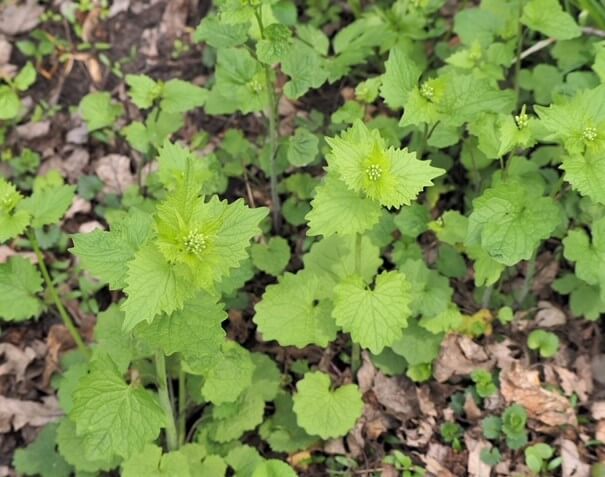
One of the earliest plants to emerge in spring, you’ll not have too many things you might confuse with garlic mustard, and its strong scent is a dead giveaway.
As a biennial, garlic mustard plant’s first year looks different from its second. In the first year, the plant forms what’s called a basal rosette, staying low to the ground. These leaves have a very strong flavor and should be used sparingly if at all. Most people recommend avoiding them altogether.
In its second year the plant sends up long flower stalks, like those shown in the photos above. It’s these that we harvest for garlic mustard recipes. Most foragers consider this stem the tastiest part of the garlic mustard plant.
Leaves:
In first-year plants, you’ll find leaves growing low to the ground in a rosette formation. On second-year plants, leaves are arranged in an alternating pattern up a long flower stalk that can reach up to 3 feet tall.
Leaves of the first year plant are heart-shaped, usually 1 1/2 to 3 inches long with rounded teeth and long reddish green petioles.
Second year plants’ leaves are heart shaped at the bottom and more elongated toward the top with prominent teeth, as you can see in the photo below.
Tearing or crushing a leaf should tell you you’ve correctly identified garlic mustard. Smells like garlic? If its features fit those described above, you’ve confirmed you found the right plant. Pull up as much as you can and get home to cook it up!

Flowers:
Small flowerheads at the top of second year plants contain numerous 4 petaled blossoms. If you grow arugula, another member of the mustard family, the little flowers will look familiar.
Try to pick garlic mustard before the flowers open for best flavor. You can cook the whole stem like you would broccoli raab.
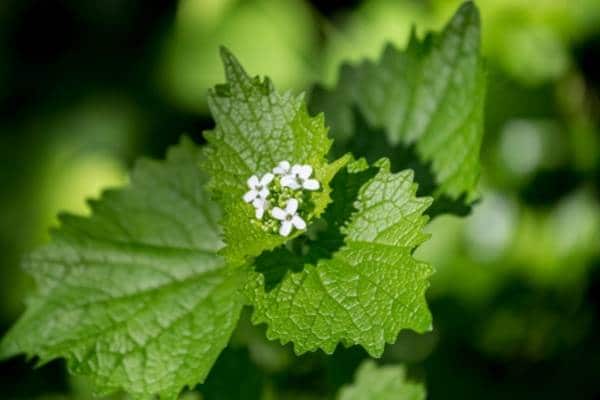
–> ALWAYS consult a good foraging guide to make certain you’re correctly identifying garlic mustard. Here are my top recommendations for the best foraging books for the forager’s bookshelf.
Want to learn more about foraging so you can gather edible and medicinal wild plants with confidence? Consider taking a foraging class in your community or online. The Herbal Academy’s online foraging course covers plant identification, ethical wildcrafting practices, and much more. Check it out!
GARLIC MUSTARD LOOK ALIKES
A few plants resemble garlic mustard, but tearing a leaf and sniffing for the telltale scent of garlic will help you distinguish it from similar-looking plants. ‘Wildman’ Steve Brill reports that there are no poisonous garlic mustard look alikes.
A few plants that might be considered garlic mustard look alikes if you’re not paying attention:
Fringecup (Tellima grandiflora) and Piggyback plant (Tolmiea menziesii). Unlike garlic mustard plant, they both have hairy stems and leaves.
Hairy bittercress (Cardamine hirsuta) is another edible mustard that some think vaguely resembles garlic mustard. Other garlic mustard look alikes mentioned in foraging guides as sometimes growing near garlic mustard weed include sweet cicely (Osmorhiza_claytonii) and early saxifrage (Micranthes_virginiensis), but a cursory look at images of these plants will easily help you distinguish them.
The leaves of creeping Charlie also resemble the lower leaves of the garlic mustard plant, but the growth habit and scent are noticeably different. If you take a taste of creeping Charlie instead of garlic mustard plant, you’ll know immediately there’s nothing garlicky about it. You’ll find more on creeping Charlie identification in this post on creeping Charlie look alikes.
WHERE TO FIND GARLIC MUSTARD
Garlic mustard grows by roadsides, and in forests, gardens, and parks. Because it’s invasive, you’ll likely come across organized events where citizen groups come together to remove it.
Ask in a neighborhood list or Facebook group, and someone will surely be able to direct you to a stand of it.
According to the Peterson Field Guide to Medicinal Plants and Herbs, its range extends from Maine to South Carolina, reaching as far west as Oklahoma.
HARVESTING TIPS
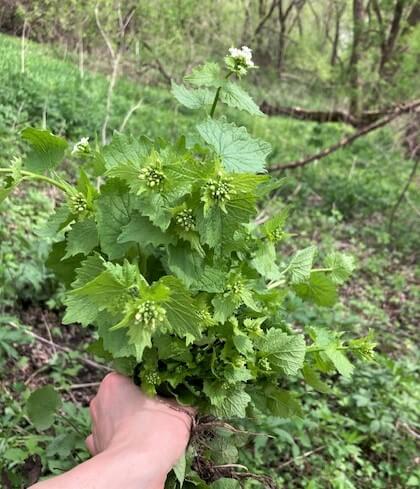
Some people’s skin may react to garlic mustard. If you find yourself developing a rash after picking, you may not want to consume it.
Garlic mustard is tastiest harvested young. Both the leaves and stems are juicy and flavorful. Garlic mustard roots can be used like horseradish. Seeds are also edible, but handle with care to avoid planting more invasive garlic mustard!
To help native plants fight back, pull the whole garlic mustard plant, even if you only plan to use part of it. Dispose of plants you’re not eating in a sealed trash bag to keep it from setting seeds and spreading further. Don’t put any in your compost!
Garlic mustard seeds can remain viable for up to ten years, so even if you pull out a whole stand of garlic mustard, you’ll likely find some growing back the following year.
If you’re interested in using the roots, dig them in spring or fall when there are no flower stalks present.
USES FOR GARLIC MUSTARD PLANT
Since it’s abundant and tasty for a short time, you’ll want to try several ways to use garlic mustard to get the most out of it. Just remember not to go overboard, especially on young leaves, which may contain more cyanide than you want to consume.
Garlic mustard can be used raw or cooked. Cooking may remove some of the bitterness if the plants you harvest don’t taste great.
If you’re still not keen on the flavor, try blanching stems in boiling water before soaking in cool water for a few hours, which should also mellow the flavor. You can change the water and soak longer to mellow it even more. Remember, stems should be milder than leaves.
♦ To use fresh garlic mustard, chop and add to any dish where you’d like a juicy, garlick-y pop of flavor. Add a little to green salads or grain salads. Garlic mustard works well in this wild rice salad recipe.
♦ Cook garlic mustard on its own or with other vegetables. Steam or saute stems, leaves, and flowers, and enjoy with a little salt and olive oil.
♦ The stems are many foragers’ favorite part. They can be prepared on their own or with other parts of the plant.
♦ Add chopped garlic mustard weed to omelets or frittatas where a garlicky bite is welcome.
♦ Stems and leaves make tasty additions to stir-fries. Here’s an easy vegetarian stir fry recipe you can try with garlic mustard plant.
♦ Add sauteed stems and leaves to pasta. They’d be especially good with asparagus in a variation on this mouth-watering spring garlic and fettucine.
♦ Chopped stems, leaves, and flowers make a delicious addition to vegetable soups. Add toward the end of cooking to avoid imparting a bitter flavor.
♦ You can make your own seasoning salt using garlic mustard leaves. Here are instructions and what to know about preserving herbs if you want to try.
♦ Blend into butter or soft cheeses to make a garlicky herb spread for crackers or toast.
♦ The root may be used as a horseradish substitute or as a spicy root vegetable.
♦ The seeds may also be used as a spice in the way you’d use mustard seed.
Need more ideas for using garlic mustard? Try some of the garlic mustard recipes below!

GARLIC MUSTARD RECIPES
♦ Here’s how to make a pesto from garlic mustard from Food 52.
♦ Try a garlic mustard chimichurri like this one from Blossom to Stem
♦ Use them as a wrap with a tasty vegan filling in the “Jumping Jack Wraps” from DiscoverWildlife
♦ Try stuffing mushrooms with garlic mustard, as in this recipe from Edible Wild Food.
♦ Find several more inventive garlic mustard recipes from Wood County, Wisconsin here.
Love foraging tasty wild plants? Check out some of these other foraging favorites:
Other wild food recipe collections to explore this season:
- 25 Wild Violet Recipes
- 35+ Genius Ways to Eat Dandelions
- 25 Inspiring Spruce Tip Recipes
- 20 Delicious Purslane Recipes
- 30 Lambs Quarter Recipes
- 15 Cool Amaranth Leaves Recipes
- 25 Serviceberry Recipes to Try This Season
- 15 Delicious Mulberry Recipes
- 15 Best Aronia Berry Recipes
Do you have favorite garlic mustard recipes? Please share in the comments!
Pin to save these garlic mustard recipes for later!
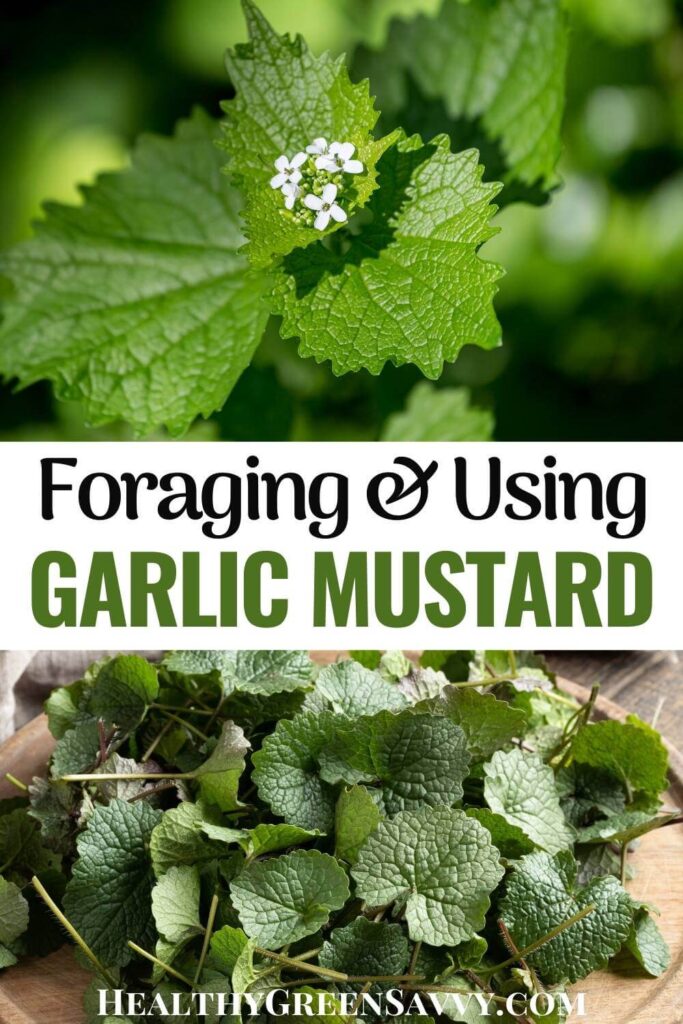
Additional garlic mustard recipes photo credits: Lemanieh, madeleinesteinbach

Susannah is a proud garden geek and energy nerd who loves healthy food and natural remedies. Her work has appeared in Mother Earth Living, Ensia, Northern Gardener, Sierra, and on numerous websites. Her first book, Everything Elderberry, released in September 2020 and has been a #1 new release in holistic medicine, naturopathy, herb gardening, and other categories. Find out more and grab your copy here.
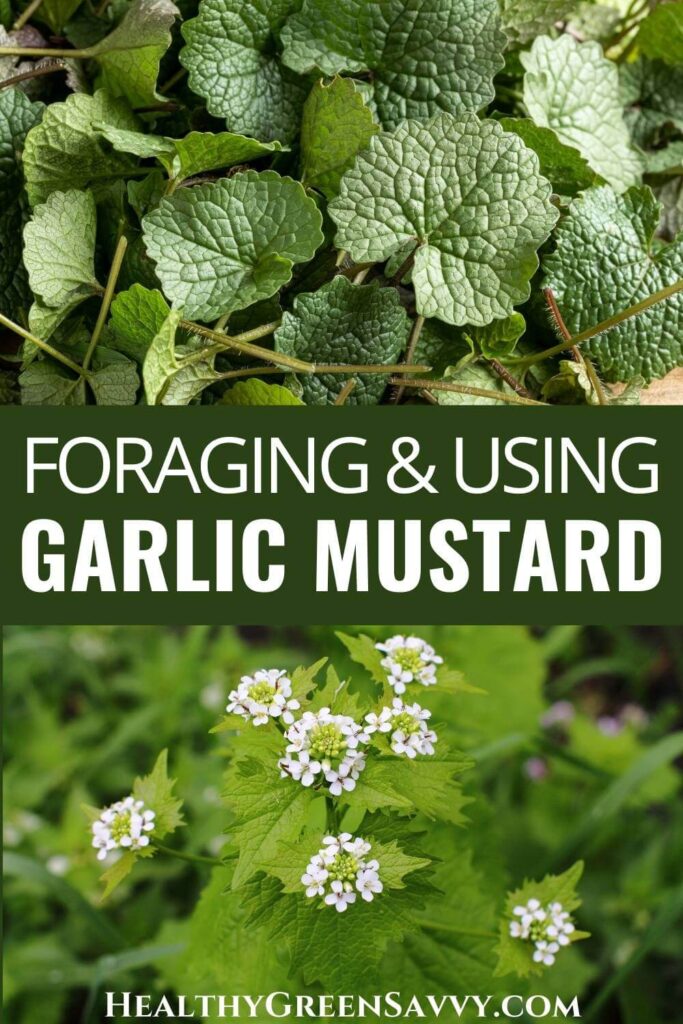
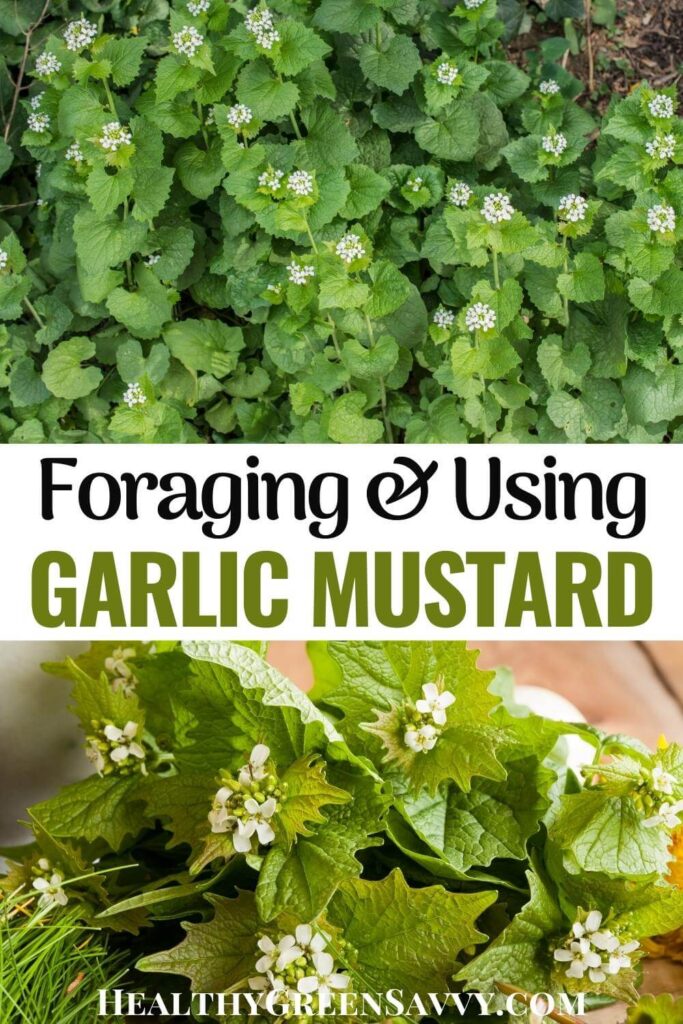

 Hi, I'm Susannah, a garden geek, energy nerd, and fan of healthy food and natural remedies. Need some simple, practical solutions for living healthier and greener? You've come to the right place! More about me and my green projects
Hi, I'm Susannah, a garden geek, energy nerd, and fan of healthy food and natural remedies. Need some simple, practical solutions for living healthier and greener? You've come to the right place! More about me and my green projects